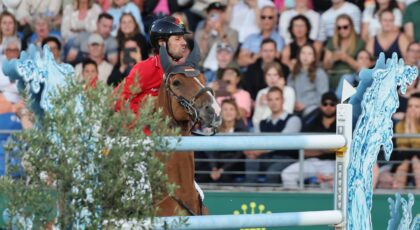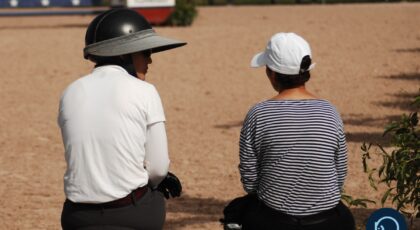To add interest and build confidence, I like to introduce young horses to ground pole patterns once they’re comfy trotting and cantering straight poles in a line.
You can find all sorts of patterns in the works of Nina Gill, Jec Ballou, Elaine Heney, and others.
A simple example is to take three ten-foot poles and set them in a triangle shape in the center of your arena or field. Again, you want plenty of space for the youngster to approach and exit. This triangle shape yields at least four different patterns and many directions for True to negotiate at a walk or trot.
Save cantering these patterns for a later stage; that can be confusing or hard for a young horse, who right now needs most to experience success with easier exercises.
I started True at a walk on the triangle.
Option 1 is to walk him over the center of one pole into the triangle and out the point in front of us. The pattern offers six directions for that option, and True works them all.
Option 2: Now we reverse direction so True walks over one of the points into the triangle and out over the center of a pole. We enjoy six directions for this too. It’s tricky at first because he isn’t sure how to approach that angled point as we enter the triangle.
When True feels comfy with Options 1 and 2 at a walk, I try them at a trot. No problems. You can do them separately on straight lines, or make three circles to approach each angle. Or all of the above!
After a few days practice with Options 1 and 2, I introduce True to Option 3, in which he walks a circle around and over each point of the triangle individually. Then we trot the same circles over each point. There will be one walk or trot step between the two poles that create each angle. Be sure to practice in both circular directions.
For Option 4, we cross the center of two poles in the triangle with two walk or trot steps between them. Here, you ride to the center of the first pole on an angle, viewing your exit across the next pole, which will also sit at an angle.
You can do all that with only three poles set in one simple triangle—it’s easy to set up, and it gave True and I all sorts of fun for a week or two. Later, we will canter the triangle.
And there are scores of other patterns to introduce. Along the way, we’re teaching the horse to pay attention to the rider, approach novel exercises calmly, stick to straight lines even when crossing poles at an angle, hold and bend into circles while crossing poles, and fear nothing. The horse learns that every strange pole pattern can be negotiated, and the variety holds her interest.
I talk a lot about baby steps in horse training because that’s where I see a lot of problems. Most human brains want to take steps in larger increments than equine brains are made to handle.
A friend of mine and an excellent horse trainer, Tik Maynard, has quantified these increments. He recommends that whenever we are teaching a horse a goal task, we work up to it in 0.5% increments. So, the very first step—like cantering one pole on the ground—is increased by only half of one percent in moving to step two. Sounds about right to me.
And in my opinion, how quickly we go through those steps is determined by the horse. She is not on my timetable; I am on hers.
Another point Tik makes is that horses cannot be trained properly in days and weeks. Instead, they’re trained in months and years.
I would add to this the advice to correct problems while they are small. If your horse tends to drift left over one canter pole, teach her to approach and follow through at the center. It’s much easier to teach that now than to wait until the canter pole is a four-foot oxer and the horse is still drifting left.
The same is true for approaches that are too fast or too slow, too eager, or too relaxed. Fix the pace, line, and animation at this early point, while the pole is just lying quietly on the ground.
Go slow and you’ll make better progress for the long term. Your horse will trust you a lot more, too!
Related reading:
Brain-Based Horsemanship is a weekly column that chronicles Janet Jones, PhD, and her journey with True, a Dutch Warmblood she trained from age three using neuroscience best practices. Read more about brain-based training in Jones’ award winning book Horse Brain, Human Brain.

A version of this story originally appeared on janet-jones.com. It is reprinted here with permission.


 November 7, 2024
November 7, 2024 

























